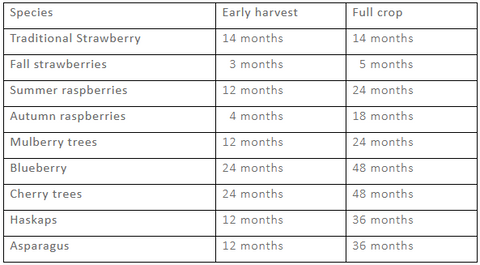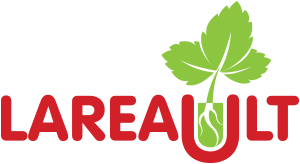Frequently asked questions
For Strawberry , the answers are here:
https://www.gov.mb.ca/agriculture/crops/production/fruit-crops/print,when-to-apply-winter-protection-to-strawberry-fields.html
For fall raspberries, mow down canes in the fall, so no need winter protection.
For summer bearing raspberries, the site selection is the important factor to prevent winter injury. It is recommended to tie plants together in the fall to avoid the damage caused by the accumulation of snow.
For blueberries, the selection of a site promoting a good accumulation of snow or the installation of snow fencing will encourage winter protection. It is possible to pass a plow between the aisles to push the snow to the plants and to promote the subsequent accumulation of snow on the plants. Do not make more than two passages, as this would instead encourage the entrance of frost in the ground, which could be even more damaging.
For gardeners, often your local Garden Centre will advise you on which products to use.
There are various providers of protection for Berry:
Dubois Agrinovation, Saint-Rémi
http://www.duboisag.com/FR
Récoltech, St-Rémi
http://recoltech.com
Agri-flex, Henryville
https://www.agri-Flex.com
Plant Product, Laval
http://www.plantproducts.com/fr/index.php
Teris Co., Laval
http://www.teris.co
Most garden centres will provide basic soil testing services. For a more complete analysis, refer to your local fertilizer and pesticide supplier. Example: Federated Coop, Agrocentre, Synagri and William Houde, etc..
When it is not possible to have access to well-drained soils, for any culture, hilling remains the first solution. The mounds should be at least 30 cm higher than the between ranks. Build the mound so that it has a gradual and not abrupt slope. For small plantings, it is also possible to amend the soil with coarse sand to improve its draining structure.
Often we see two marks on the stem near the head. The damage is caused by an insect that will lay its egg between the two lines, the larva will take the pith of the plant working toward the bottom of the stem. In severe infestation, there may be decreases in performance. In case of infestation, quickly cut the stems at the bottom of the rings and burn the stalks. As prevention for the following years, pick up the cut off stems and burn them outside the field.
Strawberry: For gardeners and small farmers, after the issuance of the first leaves, apply a complete natural or synthetic fertilizer of type 13-13-13 at the rate of 10 GR by plant. Spread the fertilizer around the perimeter of the plant and not directly on the plant. Water plants afterwards. Repeat every three weeks, and twice in the season, at the appearance of the first runners and then three weeks later.
Raspberry and BlackBerry bushes: 1st year: in the spring after the appearance of the cane, fertilize like strawberries. Repeat twice at every three weeks. 2nd year and subsequent, spread 25 g per plant that were planted originally when canes emerge, and repeat three weeks later. Spread the fertilizer around the edge of the row.
Blueberry bushes: Blueberry is a plant of poor soils that is often more damaged by excess fertilization. Do not apply any fertilizer at planting, but fertilize 2 weeks later. For small plantings, use (30-10-10) ammonia sulfate solution. For commercial plantations, spread 25 g of ammonia sulfate (21-0-0) on a diameter of 60 cm around each plant. In subsequent years fertilize from the end of April to the beginning of May. Repeat every 3 weeks (but never later than early July) especially if a mulch of sawdust is used. Gradually increase the dose as needed, while not exceeding 100-125 g per plant per year. In late summer and autumn can fertilize with sulfate of potassium and magnesium (SulPoMag) in the same amounts.
Cherry: Use the same dose as raspberries for the first two years of growth. Then fertilize only once a year either in the spring at the exit of the foliage.
Haskaps: Proceed in the same way as with the cherry.
Consult our cultivation methods, which explain the trim of the raspberries, blueberries, cherries and haskaps.
Our plants are not organic. Plants said bio or organic plants cannot be produced when part of a program to control the quality of the plants, as practised at Production Lareault Inc... Standards of tolerance to insects and diseases of this program require the use of synthetic products, particularly for the control of insect vectors of viral diseases.
In general the mulch of wood chips, fragmented chipped wood or sawdust is generally used on the row. We suggest using 10 cm thick on a 1-meter-wide strip. It is preferable to add annually, because these mulches will tend to decompose. Good weed control can be obtained with this method. For the Blueberry, avoid the balsam fir barks because of the risk of transmission of the fungus responsible for the witches' brooms disease.
Bare root strawberries: The strawberry plants have a collar with a minimum diameter of 6 mm. The roots have a length of 15 to 20 cm.
Strawberry mini tray: In mini tray strawberries are delivered in 105 cubic centimetres cells. Plants have between 10 and 15 cm in height.
Raspberry canes: Raspberries are delivered in bare roots extracted in the fall and stored in refrigerators. Canes have 30 cm long and the roots have between 25 to 45 cm long
Blueberry bush: The blueberries are supplied in 1 Litre pots. The stems of the plants have between 25 and 45 cm.
Cherry and Haskaps: These are delivered in 0.5 l pots and are between 25 and 45 cm high.
Asparagus: Our asparagus crowns are one year old and grown in disinfected and irrigated soil. The crowns have a diameter of 20 to 30 cm and an average weight of 60 to 90 gr.

For the home gardener and the small producer, sawdust mulch remains a solution that will help keep the weeds under control. Regular manual weeding will be necessary, but rendered easier by the ease of pulling the bad weeds in the mulch. Weeds that invade the edge of mulch can always be controlled with formulas of Roundup still available in garden centers. Be careful not to touch the foliage with a herbicide spray. There are other products which act by contact and contain vinegar or iron which will act in a similar way. Don't forget to add mulch every year.
For the home gardener, it is best to wait until the garden soil is dried out. Monitor the heart of plants for the first signs of growth, a small pale green leaf in the centre of the plant, and a period where the next two nights after the depaillage will be exempted from freezing. Do not remove the straw from the bottom of the row, this will diminish the presence of weeds and the incidence of disease.
This document from the Michigan State University details the straw removal:
http://msue.anr.msu.edu/news/when_to_remove_straw_mulch_in_strawberries
